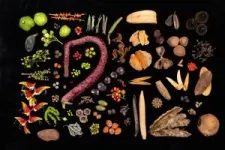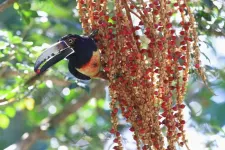(Press-News.org) Embargo: This journal article is under embargo until April 15 at 10 a.m. BST/London (5 a.m. EDT/3 a.m. MDT). Media may conduct interviews around the findings in advance of that date, but the information may not be published, broadcast, or posted online until after the release window. Journalists are permitted to show papers to independent specialists under embargo conditions, solely for the purpose of commenting on the work described
University researchers have shown that a transition to green wastewater-treatment approaches in the U.S. that leverages the potential of carbon-financing could save a staggering $15.6 billion and just under 30 million tonnes of CO2-equivalent emissions over 40 years.
The comprehensive findings from Colorado State University were highlighted in Nature Communications Earth and Environment in a first-of-its-kind study. The work from the Walter Scott, Jr. College of Engineering explores the potential economic tradeoffs of switching to green infrastructure and technology solutions that go beyond existing grey-water treatment practices. Built off data collected at over 22,000 facilities, the report provides comprehensive baseline metrics and explores the relationship among emissions, costs and treatment capabilities for utility operators and decision makers.
Braden Limb is the first author on the paper and a Ph.D. student in the Department of Systems Engineering. He also serves as a research associate in the Department of Mechanical Engineering. He said the findings are a key initial step to categorize and understand potential green solutions for wastewater.
“These findings draw a line in the sand that shows what the potential for adopting green approaches in this space is – both in terms of money saved and total emissions reduced,” he said. “It is a starting point to understand what routes are available to us now and how financing strategies can elevate water treatment from a somewhat local issue into something that is addressed globally through market incentives.”
The research was completed in partnership with the University of Colorado Boulder and Brigham Young University. Findings center around both point-source water treatment and non-point sources of water pollution.
Traditional point-source water treatment facilities such as sewage plants remove problem nutrients like nitrogen and phosphorus before releasing water back into circulation. This grey-infrastructure system – as it is known – is monitored by the Environmental Protection Agency. However, regulation standards may tighten in the future, and facilities would need more power, and in turn more emissions, to reach newly allowable thresholds. Existing facilities already account for 2% of all energy use in the U.S. and 45 million tonnes of CO2 emissions, said Limb.
Another significant source of freshwater contamination in the U.S. comes from non-point source activity such as fertilizer runoff from agriculture entering rivers. Other non-point sources of pollution can come from wildfires – aided by climate change – or urban development, for example.
Limb said that rather than building more grey-infrastructure treatment facilities to address those increasing sources, the paper explores green approaches financed through carbon markets that can tackle both types simultaneously.
“There could be a switch to nature-based solutions such as constructing wetlands or reforestation instead of building yet another treatment facility,” he said. “Those options could sequester over 4.2 million carbon dioxide emissions per year over a 40-year time horizon and have other complementary benefits we should be aiming for, such as cheaper overall costs.”
Carbon financing is a mechanism aimed at mitigating climate change by incentivizing activities that reduce emissions or sequester them from the atmosphere. Companies voluntarily buy “credits” on an open market that represent a reduction or removal of carbon from the atmosphere that can be accomplished in a variety of ways. That credit offsets the institution’s emissions from operations as it aims to reach sustainability goals.
These trades incentivize development of sustainable activities and can also provide a source of fresh money to further develop or scale up new approaches.
While there are similar financing markets for water, the problem is initially more localized than it is for air quality and carbon. That dynamic has limited the value of water market trades in the past. The paper suggests that these existing markets could be improved, and that the carbon markets could also be leveraged to change some of the financial incentives farmers have around water treatment and impacts from their activity.
The researchers found that using the markets could generate $679 million annually in revenue, representing an opportunity to further motivate green infrastructure solutions within water quality trading programs to meet regulated standards.
Mechanical Engineering Professor Jason Quinn is a co-author on the study. He said the findings have some limitations, but that this was an important first step to model both the problem and opportunity available now. He said the results in the paper have supported new research at CSU with the National Science Foundation to further develop the needed carbon credit methodology with stakeholders.
“This is the first time we are considering air and water quality simultaneously – water is local and carbon is global,” he said. “But by bringing these market mechanisms together we can capitalize on a window of opportunity to accelerate the improvement of America’s rivers as we transition to a renewable energy and restored watershed future.”
END
Switch to green wastewater infrastructure could reduce emissions and provide huge savings according to new research
Leveraging carbon-financing for wastewater infrastructure development could save $15.6 billion and just under 30 million tonnes of emissions over 40 years
2024-04-15
ELSE PRESS RELEASES FROM THIS DATE:
Specific nasal cells protect against COVID-19 in children
2024-04-15
Important differences in how the nasal cells of young and elderly people respond to the SARS-CoV-2 virus, could explain why children typically experience milder COVID-19 symptoms, finds a new study led by researchers at UCL and the Wellcome Sanger Institute.
The study, published in Nature Microbiology, focused on the early effects of SARS-CoV-2 infection on the cells first targeted by the viruses, the human nasal epithelial cells (NECs).
These cells were donated from healthy participants from Great Ormond Street Hospital (GOSH), University College London Hospital (UCLH) and the Royal ...
Tropical forests can't recover naturally without fruit eating birds
2024-04-15
New research from the Crowther Lab at ETH Zurich illustrates a critical barrier to natural regeneration of tropical forests. Their models – from ground-based data gathered in the Atlantic Forest of Brazil - show that when wild tropical birds move freely across forest landscapes, they can increase the carbon storage of regenerating tropical forests by up to 38 percent.
Birds seed carbon potential
Fruit eating birds such as the Red-Legged Honeycreeper, Palm Tanager, or the Rufous-Bellied Thrush play a vital role in forest ecosystems by consuming, excreting, and ...
Newly sequenced genome reveals coffee’s prehistoric origin story — and its future under climate change
2024-04-15
BUFFALO, N.Y. — The key to growing coffee plants that can better resist climate change in the decades to come may lie in the ancient past.
Researchers co-led by the University at Buffalo have created what they say is the highest quality reference genome to date of the world’s most popular coffee species, Arabica, unearthing secrets about its lineage that span millennia and continents.
Their findings, published today in Nature Genetics, suggest that Coffea arabica developed more than 600,000 years ago in the forests of Ethiopia ...
Human muscle map reveals how we try to fight effects of ageing
2024-04-15
How muscle changes with ageing, and tries to fight its effects, is now better understood at the cellular and molecular level with the first comprehensive atlas of ageing muscles in humans.
Researchers from the Wellcome Sanger Institute and their collaborators at Sun Yat-sen University, China applied single-cell technologies and advanced imaging to analyse human skeletal muscle samples from 17 individuals across the adult lifespan. By comparing the results, they shed new light on the many complex processes underlying age-related muscle changes.
The atlas, published ...
Study shows key role of physical activity and body mass in lung function growth in childhood
2024-04-15
A new study led by the Barcelona Institute for Global Health (ISGlobal), a centre supported by the "la Caixa" Foundation, sheds light on the growth of lung function in children. The results show that increased levels of physical activity and a higher body mass index (BMI) play a key role in the recovery of early deficits. These findings, published in the journal Thorax, have important implications for clinical practice, research and public health policy, providing new insights into how to improve respiratory health from childhood to adulthood.
The study analysed data from the ...
Security vulnerability in browser interface allows computer access via graphics card
2024-04-15
Modern websites place ever greater demands on the computing power of computers. For this reason, web browsers have also had access to the computing capacities of the graphics card (Graphics Processing Unit or GPU) in addition to the CPU of a computer for a number of years. The scripting language JavaScript can utilise the resources of the GPU via programming interfaces such as WebGL and the new WebGPU standard. However, this harbours risks. Using a website with malicious JavaScript, researchers from the Institute of Applied Information Processing and Communications at Graz University of Technology (TU Graz) were able to spy on information about data, keystrokes and encryption ...
Physical activity reduces stress-related brain activity to lower cardiovascular disease risk
2024-04-15
Key Takeaways
Results from a new study indicate that physical activity may help protect against cardiovascular disease in part by reducing stress-related brain activity
This effect in the brain may help to explain why study participants with depression (a stress-related condition) experienced the greatest cardiovascular benefits from physical activity.
BOSTON – New research indicates that physical activity lowers cardiovascular disease risk in part by reducing stress-related signaling in the brain.
In the study, which was led by investigators at Massachusetts General Hospital (MGH), a founding member of the Mass General Brigham healthcare ...
Inaugural International COSPAR Planetary Protection Week: Set to inspire global collaboration in London
2024-04-15
With an increasing number of space missions targeting various celestial bodies, including Mars, Europa, and the Moon, the importance of maintaining the integrity of these environments while protecting our own biosphere has never been greater. The ICPPW will serve as a platform for promoting international collaboration and knowledge exchange on best practice in planetary protection.
The event will feature a range of sessions, meetings, as well as panel discussions, covering key topics such as the current and ...
A quarter of deaths among young adults in Canada were opioid related in 2021
2024-04-15
Premature deaths related to opioids doubled between 2019 and 2021 across Canada, with more than 1 in 4 deaths among young adults aged 20–39 years attributable to opioids, according to new research published in CMAJ (Canadian Medical Association Journal) https://www.cmaj.ca/lookup/doi/10.1503/cmaj.231339.
Opioid-related deaths have continued to increase over the past decade across Canada, with 6222 deaths occurring in 2021. This trend worsened during the COVID-19 pandemic, although the scale and rapidity of increases varied across provinces and territories. ...
Severe morning sickness: how to diagnose and treat
2024-04-15
Severe morning sickness in pregnancy, known medically as hyperemesis gravidarum, can negatively affect both maternal and infant health. A review published in CMAJ (Canadian Medical Association Journal) https://www.cmaj.ca/lookup/doi/10.1503/cmaj.221502 provides information to clinicians on the causes, diagnosis, and treatment of the condition.
Although nausea and vomiting are common in pregnancy, affecting as many as 70% of pregnancies, severe vomiting and nausea can prevent people from eating and drinking sufficiently, leading to weight loss and ...
LAST 30 PRESS RELEASES:
Electrons lag behind the nucleus
From fungi to brain cells: one scientist's winding path reveals how epigenomics shapes neural destiny
Schizophrenia and osteoporosis share 195 genetic loci, highlighting unexpected biological bridges between brain and bone
Schizophrenia-linked genetic variant renders key brain receptor completely unresponsive to both natural and therapeutic compounds
Innovative review reveals overlooked complexity in cellular energy sensor's dual roles in Alzheimer's disease
Autism research reframed: Why heterogeneity is the data, not the noise
Brazil's genetic treasure trove: supercentenarians reveal secrets of extreme human longevity
The (metabolic) cost of life
CFRI special issue call for papers: New Frontiers in Sustainable Finance
HKU Engineering scholar demonstrates the smallest all-printed infrared photodetectors to date
Precision empowerment for brain "eavesdropping": CAS team develops triple-electrode integrated functional electrode for simultaneous monitoring of neural signals and chemical transmitters during sleep
Single-capillary endothelial dysfunction resolved by optoacoustic mesoscopy
HKU three research projects named among ‘Top 10 Innovation & Technology News in Hong Kong 2025’ showcasing excellence in research and technology transfer
NLRSeek: A reannotation-based pipeline for mining missing NLR genes in sequenced genomes
A strand and whole genome duplication–aware collinear gene identification tool
Light storage in light cages: A revolutionary approach to on-chip quantum memories
Point spread function decoupling in computational fluorescence microscopy
BacPhase: Long-insert paired-end sequencing for bin marker construction and genome phasing
GmWOX1 regulates the mediolateral polarity of compound leaves in soybean
ChargeFabrica: An open-source simulation tool that aims to accelerate search for high performance perovskite solar cells
High levels of ADAR overexpression induce abundant and stochastic off-target RNA editing in rice protoplasts
On-demand upgraded recycling of polyethylene and construction of sustainable multifunctional materials based on the "LEGO" strategy
New "Stomata in-sight" system allows scientists to watch plants breathe in real-time
Anorexia nervosa may result in long-term skeletal muscle impairment
Narrative-based performance reviews deemed fairest by employees
New insights reveal how advanced oxidation can tackle emerging water pollutants
New review shows how biomass can deliver low-carbon gaseous fuels at scale
Climate change is quietly rewriting the world’s nitrogen cycle, with high stakes for food and the environment
Study finds SGLT-2 inhibitors linked to lower risk of diabetic foot nerve damage
Microbes may hold the key to brain evolution
[Press-News.org] Switch to green wastewater infrastructure could reduce emissions and provide huge savings according to new researchLeveraging carbon-financing for wastewater infrastructure development could save $15.6 billion and just under 30 million tonnes of emissions over 40 years





